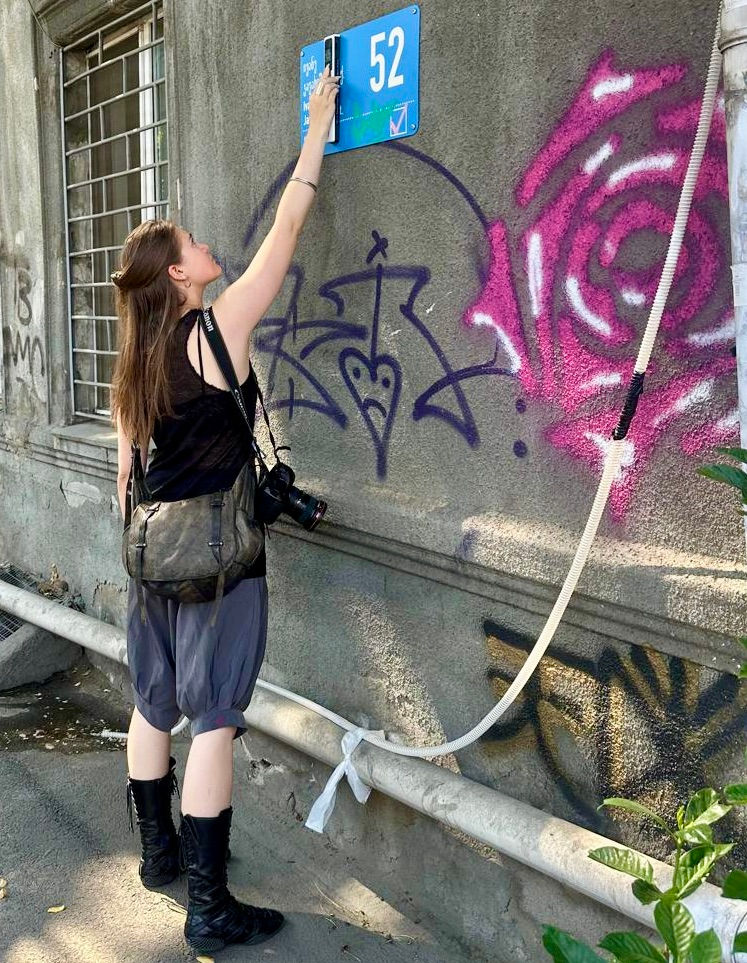Sophie Klampferer, University of the Arts London
- ivyoptionswebsite
- 23 hours ago
- 4 min read

As a graduate student in filmmaking at the University of the Arts London, Sophie’s latest fascination is the city's surfaces–its walls, pavements, and hidden cracks–and the histories they reveal. While working on a documentary about graffiti culture, the Austrian-Kazakhstanti, who grew up in Dubai, became fascinated with applying portable scanning– typically used for flat documents–on textured surfaces. She says her experimental techniques and results have sparked a new creative vision.
IO: Congratulations on starting your master’s degree! Tell us about your program and what you are studying.
Sophie: I am currently attending Central Saint Martins College of Art, part of the University of the Arts London, pursuing a Master of Arts in Performance: Screen. Despite its somewhat pretentious title, the program is essentially a filmmaking course with a focus on experimental approaches. My main interest lies in documentary filmmaking. While I am still exploring my exact path after graduation, I know I am particularly drawn to documentary and fashion film, building on my background in fashion photography.
IO: You have such a creative background. How did your interests develop, and what inspires your creativity?
Sophie: I’ve always felt that my interests—always rooted in moving images—span many directions, but I deeply love photography; I’m drawn to finding a way to merge the two into a single medium. Recently, I’ve discovered a passion for portable scanning, which is literally using an apparatus that is meant for paper documents, but I have started to use it for textures. While working on a documentary about graffiti culture in London, I became intrigued by urban surfaces that carry layers of history—the palimpsest of a city. This process awakened a new way of visualization for me, where every wall, mark, and texture holds a story. I’m now developing my scanning practice further and exploring how it can be expanded into future projects, both as a visual language and as a method of archiving urban memory. I’ve always lived in big cities and been drawn to the endless cracks of a palimpsest that grows unnoticed all around us. I am constantly observing and pushing myself into overlooked spaces, driven by a pure, restless curiosity.
IO: What made you pursue graduate studies after getting your bachelor’s at King’s College?
Sophie: Honestly, I chickened out of attending UAL for my undergraduate studies. I think I was intimidated by starting out on a practical, hands-on course without knowing exactly what kind of films I wanted to make. In hindsight, I am so happy about this because there is no way I would have transitioned to the type of work I do now if I had attended a classical filmmaking course. Instead, I studied English and film at King’s, but the program was much more theoretical. I found myself craving active, filmmaking experience, which ultimately led me to pursue a master’s degree in a program that would challenge me to develop real, practical filmmaking skills, and grow as a filmmaker.
IO: What was the graduate application process like, and how did it differ from applying to undergraduate programs? Did you have to submit an art portfolio?
Sophie: I only applied to graduate programs in the UK, London specifically, partly because of the lower tuition fees, but also because I had already had a strong creative base there: I’d met people I knew I wanted to continue working with, and I had started to build a life in a city that resonates with me. I applied to three programs at UAL–two at Central Saint Martins and one at the London College of Fashion–all of which focused on either film or photography.
The application process was grueling. I spent a long time compiling my portfolio and tailoring it carefully to each course, showcasing only my best work. The courses required extensive documentation and process work for the final portfolio, so I spent a lot of time compiling my notebook pages filled with notes, sketches, and mood boards. UAL’s process has four stages: first you submit your written work and application, then your portfolio, followed by a video submission, and finally the interview. Applying for a master’s degree is very different from applying for an undergraduate program. The process is much more specific, and by that point in life you generally have a clearer sense of what you want to achieve.
IO: You worked with Ivy Options on your portfolio for undergraduate applications. Tell us about your high school artistic endeavors and the type of portfolio you eventually submitted for university applications.
Sophie: I remember that many U.S. universities required extremely large portfolios—some even asked applicants to create new work based on specific prompts rather than submitting existing projects: I had to write short stories, scripts, and short films. I felt uneasy during the process, wondering why I was adjusting myself to fit a specific program instead of spending that time exploring what I truly wanted from the course and experimenting with different approaches. Applying to UK universities was somewhat simpler, as the courses I applied to were mostly theory-based, relying more on written applications than on practical work. Luckily, I had my incredible Ivy Options counselor, who was instrumental in guiding me through the application process. She helped me clarify my ideas, kept me organized, and provided great guidance so that the entire experience felt seamless.
IO: In hindsight, given all your experiences, what advice would you give to yourself and other high school students?
Sophie: To calm down. In a few years, you’ll look back and laugh at how much you stressed over all of this.



Comments